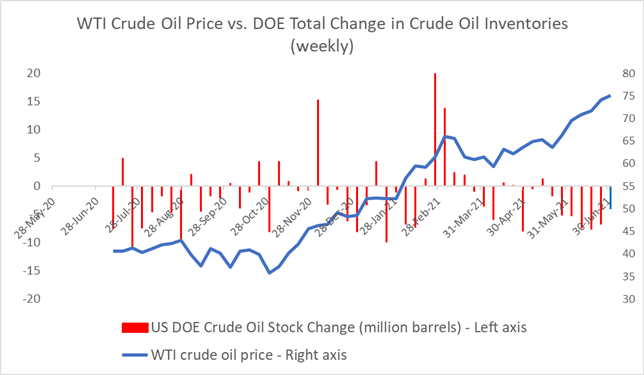CRUDE OIL PRICE OUTLOOK:
- Oil prices fell for a second day as traders mulled uncertainties surrounding OPEC+ output plan
- A stronger US Dollar and souring market sentiment also weighed on energy prices
- US shale oil production has risen in recent months as prices recovered
Crude oil prices extended lower during Wednesday’s APAC session after falling 3.3% a day ago. Prices briefly hit a six-year high at $76.95 on Tuesday before turning sharply lower after OPEC+ members failed to reach an agreement to increase supply. Still, some market participants are anticipating a deal to be struck in the coming weeks as the oil cartel seeks to meet rising global fuel demand while stabilizing prices.
On the other hand, investors are worried that recent spat between Saudi Arabia and the United Arab Emirates will ignite a price war among OPEC+ members if the existing production cut agreement breaks down.
In recent months, a sharp rebound in energy prices have encouraged America’s shale oil producers to increase capacity (chart below). Current oil prices are far above the estimated full-cycle breakeven price of $46 a barrel for shale, according to JPMorgan Chase’s latest report. This makes American’s shale oil drilling more profitable and may encourage additional supply in the months to come. A substantial increase in shale output may neutralize a temporary stall of the output hike from OPEC+ and cap the upside potential for oil.
WTI vs. US Shale Oil Production – 2018-2021
Source: Bloomberg, DailyFX
Souring market sentiment and a stronger US Dollar also weighed on prices today. The emergence of the Delta variant of the Covid-19 virus is threatening a new round of lockdowns and travel restrictions around the world, casting a shadow over a fragile and uneven recovery of the global economy. A rally in US Treasury notes and a strengthening Japanese Yen reflect rising demand for safety.
On the demand side, US crude inventories have been falling for 6 weeks in a row (chart below), reflecting tightened market conditions as refiners geared up capacity to meet demand for the summer driving season. The Energy Information Administration (EIA) will publish its weekly petroleum status report on Thursday, with a 4.0-million-barrel draw expected. A larger-than-expected fall in stockpiles would likely strengthen prices, whereas a smaller draw or a rise may lead to the reverse.
WTI vs. Crude Inventory Changes – Past 12 Months

Source: Bloomberg, DailyFX
Technically, WTI pulled back from recent highs as the MACD indicator formed a bearish crossover, suggesting that prices might have been overbought and are due for a technical correction. The overall trend remains bullish-biased as suggested by upward-sloped SMA lines. An immediate support can be found at $72.85 – the 20-day SMA line, followed by $70.00 – the 38.2% Fibonacci extension.
WTI Crude Oil Price – Daily Chart

— Written by Margaret Yang, Strategist for DailyFX.com
To contact Margaret, use the Comments section below or @margaretyjy on Twitter


Be the first to comment